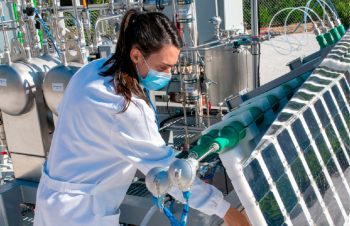
Tuesday, August 24, 2021
After almost a decade of work, a joint team of researchers from Repsol and Enagas has developed a cutting-edge technology for the production of renewable hydrogen from direct use of solar energy, through a process known as photoeletrocatalysis.
This project is a 100% Spanish R&D development, led by women, and carried out in collaboration with several of the most prestigious hydrogen research centers in the country. The next step will be the construction of a demo plant in Repsol’s Puertollano industrial complex, with the aim of reaching commercial maturity before 2030.
Ana Martínez, Researcher at the Repsol Technology Lab and one of the project leaders, highlights the role that hydrogen will play as a key energy driver in the decarbonization of our societies: “It will allow us, on the one hand, to store renewable energy on a large scale, and, on the other, to use it as fuel in different sectors, such as mobility, in the residential and industrial fields and, also, as a raw material in the industry.
Photoelectrocatalysis, which allows only water and solar energy to be used to produce renewable hydrogen, is one of the technological ways Repsol works to decarbonise the generation of this gas. “We are the leading producer and consumer of hydrogen in Spain and this technology represents a total reduction in emissions in relation to the conventional methods used to generate H 2 “, says María Dolores Hernández, co-leader of the project. “The boost that Repsol is giving to projects related to renewable hydrogen and, specifically, through this technology, will allow us to continue advancing in our commitment to multi-energy and sustainability, with the goal of being zero net emissions by 2050”.
Research on photoelectrocatalysis technology started at Repsol Technology Lab in 2012 and, in 2018, Enagás joined the project with an agreement that makes both companies co-owners. “It is a very disruptive technology,” says Mónica Sánchez, Enagás Hydrogen Coordinator, “which is part of our commitment to renewable gases, specifically hydrogen and biomethane, as key pieces to achieve the carbon neutrality that we want to achieve at the level European, and specifically as a company for 2040.”
For the full story along with graphics, visit Repsol here.